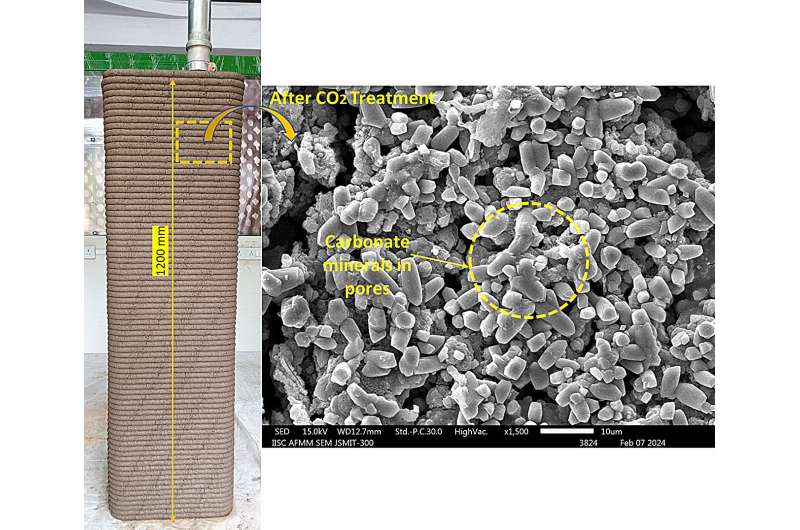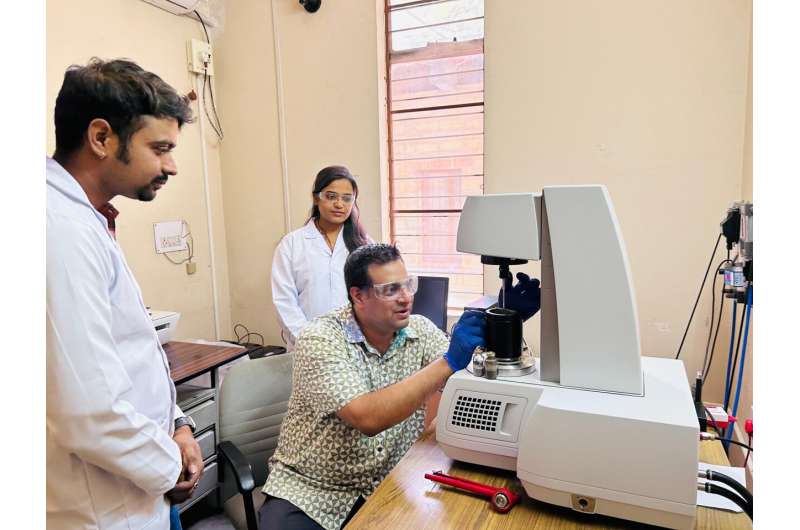
The construction sector today faces several challenges. Natural sand is fast becoming a scarce resource—we might run out of it by 2050. Carbon dioxide emissions, especially from manufacturing cement or fired clay bricks, are increasing every year. The amount of construction and demolition (C&D) waste is on the rise—about 150 million tons are generated annually in India and the recycling rate is only about 1%.
To address such challenges, researchers at the Center for Sustainable Technologies (CST), Indian Institute of Science (IISc), are exploring ways to store carbon dioxide from industrial flue gas in excavated soil and C&D waste. These materials can then be used to partially replace natural sand. This would not only reduce the environmental impact of construction materials but also impart properties that can enhance their use for construction.
"CO2 utilization and sequestration can be a scalable and feasible technology for manufacturing low-carbon prefabricated building products, while being aligned with the nation's decarbonization targets," explains Souradeep Gupta, Assistant Professor at CST, whose lab is carrying out these studies.
Gupta's team has shown in Construction and Building Materials that replacing natural sand with carbon dioxide-treated C&D waste in mortar and then curing it in a controlled, CO2-rich environment can speed up the development of the material's engineering properties, and enhance its compressive strength by 20–22%.
His lab has also tested the effect of injecting carbon dioxide gas into clayey soil—typically excavated from construction sites. This resulted in better stabilization of clay by cement and lime, and reduced the surface area, pore volume and lime reactivity of clay in soil, thereby improving the bulk engineering performance of the material. Results were published in Developments in the Built Environment.

In a more recent study in Science of The Total Environment, Gupta's team checked to see what happens when carbon dioxide is sequestered in excavated soil to develop cement-lime-soil materials, which are then used to replace up to 25% and 50% of fine aggregates by mass in mortar.
"When you sequester carbon dioxide in cement-soil materials, tiny crystals of calcium carbonates are formed, which reduce the fraction of medium capillary pores, densify the interfacial zones and thus improve the compressive strength," explains Ashutosh Dwivedi, first author and Ph.D. student at CST. Exposing the cement-lime-soil block to carbon dioxide increased their early-age strength by about 30%, the team found.
Gupta explains that carbon dioxide exposure after preparation also cuts down their curing time—the time they require to harden before being used in construction.
The team has also developed 3D-printable materials made of excavated soil stabilized with a combination of binders like Portland cement, blast furnace slag (a granular calcium-silicate byproduct) and fly ash. Details were also published in Science of The Total Environment.
They found that the non-expansive clay in the excavated soil acts as an excellent thickening agent (rheological modifier) and causes the material to display superior extrusion and buildability when compared to conventional cement-sand mortars. Using these materials could also reduce the amount of cement and natural sand needed in mortar by 30% and 50% respectively, they found.
Moving forward, the team plans to examine the effect of industrial and simulated flue gas—which contains a combination of gases like carbon dioxide, sulfur dioxide, nitrogen oxide and others—on the micro and macro properties of these newly formulated materials. This would help them understand whether gases other than carbon dioxide released by industries affect the materials' carbon-capturing potential and engineering properties.
The team is in talks with a couple of major construction companies to apply these findings to their manufacturing plants. Gupta is also part of a national committee currently working on revising the standards for natural and recycled aggregates in cement-based construction materials.
"The climate change impacts of construction materials, exacerbated by increasing CO2 emissions and sand scarcity, are increasing every year," he says. "Finding alternatives to natural sand is the need of the hour."
More information: Prabhath Ranjan Kumar Soda et al, Development of 3D printable stabilized earth-based construction materials using excavated soil: Evaluation of fresh and hardened properties, Science of The Total Environment (2024). DOI: 10.1016/j.scitotenv.2024.171654
Ashutosh Dwivedi et al, Carbon dioxide sequestration in mortars with excavated soil: Engineering performances and environmental benefits, Science of The Total Environment (2024). DOI: 10.1016/j.scitotenv.2024.170285
Ashutosh Dwivedi et al, Influence of carbon sequestration in natural clay on engineering properties of cement-lime stabilized soil mortars, Developments in the Built Environment (2023). DOI: 10.1016/j.dibe.2023.100270
Pitabash Sahoo et al, Sequestration and utilization of carbon dioxide to improve engineering properties of cement-based construction materials with recycled brick powder: a pathway for cleaner construction, Construction and Building Materials (2023). DOI: 10.1016/j.conbuildmat.2023.132268
Citation: Paving new paths for sustainable construction (2024, March 27) retrieved 27 March 2024 from https://techxplore.com/news/2024-03-paving-paths-sustainable.html
This document is subject to copyright. Apart from any fair dealing for the purpose of private study or research, no part may be reproduced without the written permission. The content is provided for information purposes only.
